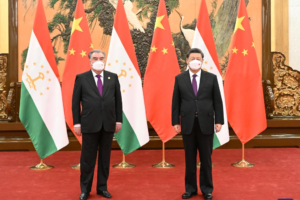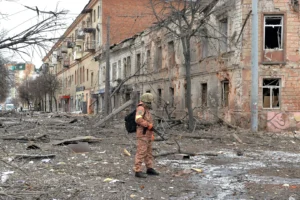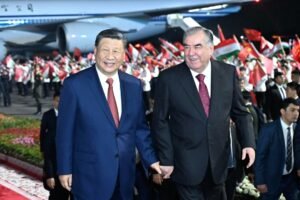Japanese travel to Hawaii has not returned to pre-pandemic levels, defying the predictions of tourism executives and economists who had forecast the state’s most important international visitor market would rebound as travel restrictions eased.
Heading into Hawaii’s prime holiday travel season, with the Honolulu Marathon sponsored by Japan Airlines less than two weeks away, Hawaii simply isn’t as big in Japan as it once was.
The number of visitors from Japan is roughly half of what it was in 2019, before the Covid-19 pandemic shut down the state’s tourism industry, tourism executives say, and data shows the Japanese visitors who are coming are tightening their belts.

“We’re not getting the big influx back that we thought a year ago would happen,” said Jerry Gibson, president of the Hawaii Hotel Alliance. “Eventually it will come back to at least 85%. But it’s not going to be as quick as we thought it would be.”
Much of that has to do with prices: rising U.S. inflation coupled with a weaker yen that makes Hawaii far more expensive for Japanese than it was before the pandemic.
“Hawaii just looks super expensive,” Carl Bonham, executive director of the University of Hawaii Economic Research Organization, said during a recent interview with Civil Beat’s editorial board. The cost increase is especially sharp since before the Covid-19 pandemic, he said.
To illustrate, Bonham points to a hypothetical visitor from Japan who had scheduled a trip during Japan’s holiday Golden Week in 2020, only to have to cancel because of Covid-19 travel restrictions.
“You know exactly how much it was going to cost because you already had it all booked,” Bonham said. “And now you try to book the same thing. You’re talking 60, 70, 80% more expensive. And so that matters.”
Honolulu Sticker Shock
Junji Furusawa was one of those not daunted by the high prices. He arrived Tuesday on a flight from Tokyo’s Haneda International Airport on Tuesday with his wife Sugiko and their grown children.
The Furusawas were among 2,555 passengers who arrived on flights from Japan on Tuesday. That was about 46% less than the 4,766 who arrived from Japan on the same day in 2019, international passenger data from the Hawaii Department of Business, Economic Development and Tourism shows.
But the numbers alone don’t tell the whole story. According to Furusawa, who spoke to Civil Beat through an interpreter, there were more “foreigners” on the plane, or people flying home from Japan, than there were Japanese people flying to Hawaii.
It’s not surprising given the prices, Furusawa said during an interview on Wednesday at Ala Moana Center, where he was shopping with his family. Furusawa said he had been to Hawaii about 25 times, the last visit a decade ago.
And he said he was struck by how much more expensive Hawaii is now that it was back then. A bowl of noodles for lunch at Marugame Udon in Waikiki, for instance, cost three times what it costs in Tokyo, he said.
“The hotel is more than twice the price of 10 years ago,” he said.
The cost of travel to Hawaii was a common theme among visitors interviewed Wednesday. And for good reason. The weakest Japanese yen in 30 years means U.S. travelers to Japan can stretch their dollars, but Japanese visitors are at the wrong end of the exchange rate, paying a premium for goods and services that have already increased in price due to inflation.
It’s not that Japanese tourists are stingy. It’s just that they’re putting the brakes on their spending, while U.S. travelers are spending more. In fact, for the third quarter of 2023, the average Japanese tourist in Hawaii spent $249.50 per day here, compared to $226.20 per day for the average visitor from the U.S. West. Before the pandemic, U.S. West visitors were spending a lot less – $173.90 a day in the third quarter of 2019 – than Japanese visitors, who were spending $239.50 a day then.

Ko Suzuki, a driver for Royal Kaila Wedding and Spa, spends his days shuttling Japanese tourists from their hotels to Royal Kaila, where they get dressed up in wedding clothes for photo shoots on the beach. A basic sunset photo package sells for $1,169, including 100 photos, a rental wedding dress and tuxedo, bridal hair and makeup, limousine service and other amenities.
While wedding couples might be willing to splurge for once-in-a-lifetime wedding photos, Suzuki said through an interpreter he often finds himself recommending inexpensive local restaurants to couples who say they’re surprised to find places here charging $20 for a bowl of ramen that costs $7 to $10 back home.
But it’s not just prices people cited as concerns. Kaito Kitahara and Kana Jimbo, who are visiting Waikiki for six days from Kanagawa Prefrecture near Tokyo, said they would like to see improvements to Honolulu’s bus service, including better signage at bus stops and more payment options.
“It would be nice to be able to use a credit card on the bus,” Kitahara said through an interpreter.
Another issue, Furusawa said, is clearing U.S. customs and immigration, which can take a frustratingly long time. Also raising concerns about custom and immigration, he said, is a recent high-profile news story of a social media influencer being turned away from Hawaii as a suspected prostitute.
But Sugiko Furusawa said the family recently saw something encouraging: Hawaii Gov. Josh Green on the news in Japan promising to address immigration issues for visitors during a recent trip to Japan.
In an emailed statement, Green’s office said, “The Immigration Clearance discussions that Governor Green referred to would create a system in Japan where Japanese Visitors would conduct their U.S. Customs and Immigration Clearance prior to flying to Hawaiʻi which would expedite their processing time upon arrival to the State of Hawaiʻi.”

A more fundamental issue involves a lack of Japanese-speaking service workers in Hawaii, Royal Kaila’s Suzuki said. Many such workers were laid off during the pandemic and never went back to work. The result is some visitors face occasional language barriers that never existed in Hawaii before the pandemic.
About 90% of the company’s customers are Japanese tourists, he said, and he hears their stories when he shuttles them between their hotels and Royal Kaila.
For Royal Kaila, the lack of Japanese-speaking workers like makeup artists, hairdressers and photographers is especially problematic, Suzuki said. While the company handled upward of 18 wedding shoots a day before the pandemic, he said, the company can now do only six to eight.
“There were lots of layoffs during the pandemic,” he said. “We can’t yet deal with all the demands.”
When things will return to pre-pandemic levels is anyone’s guess.
Gibson said it could be five to seven years.
UHERO’s Bonham said an important part of the story is that U.S. visitors have stepped up to fill the gap left by the missing Japanese visitors. And there’s no sign that economic conditions will change that soon.
“If you went back and sort of looked back at our forecasting behavior over the last year, year and a half, what you would find is that every time we released another forecast, we had to increase our forecast for U.S. visitors, and we had to lower our forecast for Japanese visitors,” he said.
U.S. visitors now make up 75% of the visitors to the state and 75% of the spending in the state, which is about 10 percentage points higher than before the pandemic, he said.
“And meanwhile,” Bonham added, “we keep waiting for the Japanese visitor to come back.”
Source : CivilBeat











